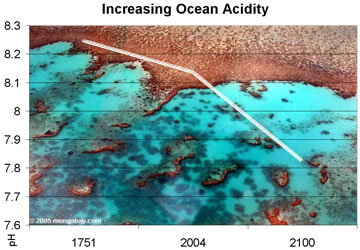CO2 emissions cause ocean acidification, threaten sea life
CO2 emissions cause ocean acidification, threaten sea life
mongabay.com
September 21, 2007
Human-induced carbon dioxide (CO2) emissions could alter ocean chemistry to the point where it will violate U.S. Environmental Protection Agency Quality Criteria by mid-century if emissions are not significantly reduce, reports a team of scientists writing in the September 25, 2007 issue of Geophysical Research Letters. The commentary is the first to warn that atmospheric CO2 emissions will cause ocean waters to violate EPA water quality criteria.
“Atmospheric CO2 concentrations need to remain at less than 500 ppm for the ocean pH decrease to stay within the 0.2 limit set forth by the U.S. Environmental Protection Agency [1976],” said lead author Ken Caldeira from the Carnegie Institution Department of Global Ecology. “If atmospheric CO2 goes above 500 ppm, the surface of the entire ocean will be out of compliance with EPA pH guidelines for the open ocean. We need to start thinking about carbon dioxide as an ocean pollutant. That is, when we release carbon dioxide to the atmosphere, we are dumping industrial waste in the ocean.”

Observed and projected decline in global ocean pH, 1750-2100. Photo by Rhett A. Butler |
Scientists say ocean acidification poses a great threat to marine life and ecosystems, especially organisms that use calcium carbonate to form shells and skeletons, like phytoplankton and corals.
“About 1/3 of the CO2 from fossil-fuel burning is absorbed by the world’s oceans,” explained Caldeira. “When CO2 gas dissolves in the ocean it makes carbonic acid which can damage coral reefs and also hurt other calcifying organisms, such as phytoplankton and zooplankton, some of the most critical players at the bottom of the world’s food chain. In sufficient concentration, the acidity can corrode shellfish shells, disrupt coral formation, and interfere with oxygen supply. ”
Atmospheric CO2 levels presently stand at 380 ppm, but are expected to reach 500 ppm by mid-century. For comparison, pre-industrial concentrations were 280 ppm.
CITATION: Ken Caleira et al (2007). Geophysical Research Letters. September 25, 2007
Related articles







